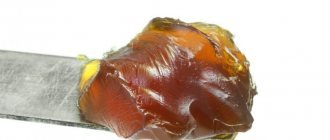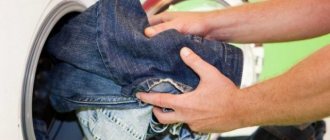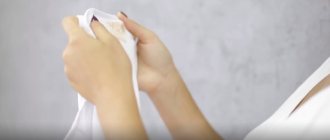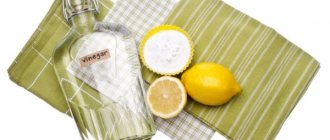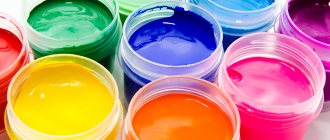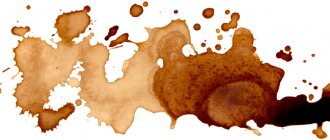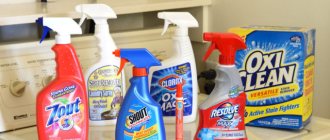Red, orange and green marks from fruits and vegetables that appear on clothing are considered the most persistent and insidious. In this article you will learn how to remove a tomato stain, because it is this fruit and vegetable, which takes on different forms in food, that most often appears on our favorite things.
Pastas, sauces, ketchups, salads, soups, stir-fries and much more, this is not a complete list of dishes that cannot be imagined without the “golden apple”. Therefore, it is very easy to detect contamination from a tomato on yourself, but you will have to fight it thoroughly.
How to wash tomato from clothes
Many housewives have repeatedly encountered such contamination, but some of the clothes had to be thrown away, since the persistent substances that make up the vegetable penetrate deep into the fabric, absorbing into its fibers. When we put a soiled item into the washing machine, we think that we are removing the stains, although we see yellow marks afterwards.
To wash a tomato from clothes, you need to adhere to the basic rules, since first they treat the stained area and try to remove as much contamination as possible. Only after you apply the stain remover to the contaminated area will the treated item be washed, and not vice versa.
As a rule, many people make a mistake at this step, but we must not forget that a tomato stain sent to the wash without preliminary cleaning can not only leave yellow stains on the fabric, but also become embedded in it so that the clothes are ruined. Therefore, to avoid unpleasant consequences, try to wash off tomato juice correctly, following the recommendations.
Why is tomato juice dangerous?
Tomato fruits contain a special coloring substance of the carotenoid family - lycopene. Carotenoids are responsible for the bright (yellow, orange, red) color of many vegetables, fruits and flowers - carrots, tomatoes, pumpkins, peppers. Lycopene is insoluble in water.
For this reason, stains on fabric from any tomato derivatives, be it tomato paste, juice, ketchup or sauce, are quite difficult to remove. And it is tomato juice that is the most harmless of those listed, since, unlike sauce, it contains no fat.
In any case, do not despair, some practical tips will help you save your favorite thing.
Types of stains
It is impossible to imagine preparations for the winter without tomatoes, because they can be preserved both independently and by adding them as an ingredient to other dishes. Consequently, during preparation or actual cooking, it is very easy to get dirt on your T-shirt or sweater, which must be dealt with immediately. But, if you have your own garden, then you know that not only orange spots from tomato juice can appear on things, but also green spots from tomato leaves.
Each type of pollution requires its own approach, so the following are distinguished::
- Green tomato tops stains. These stains are similar to grass stains and are quite difficult to remove. But the solution is hidden in the fruits themselves, so by taking an unripe green vegetable, you can neutralize traces of the tops with its juice.
- A stain of tomato paste (ketchup). These stains are the most common, so there are many products that can remove tomato sauce. To treat stains, use salt, acids (vinegar, lemon), ammonia, bleaches, etc.
- A trace from a fresh fruit. Similar contaminants, as in the example with tops, can be neutralized by the same vegetable, but completely green.
What to do if the carpet stinks after washing?
The appearance of an unpleasant musty damp smell from the carpet is directly related to the effect of water on the carpets or the constant use of carpets in damp rooms that are rarely ventilated. It is also possible that the carpet stinks after washing and subsequent improper drying. The source of the unpleasant rotten smell is bacteria and fungus that grow in the carpet.
- After wet cleaning and washing, carpets must be completely dried (both the pile and the base of the carpet). If you washed the carpet yourself, or in a dry cleaner, or even in a car wash and did not dry it completely, then there is a very high probability that in the coming days an unpleasant odor (or even a fairly strong stench) will appear, which will not be so easy to deal with on your own. Read more about drying carpets here.
- If the carpet is used in rooms with high humidity, it must be dried periodically and the condition of the pile and base of the carpet must be monitored (so that they are not wet and mold does not appear), and the room itself must be ventilated more often and special air dehumidifiers must be used.
- Some dry cleaners offer special treatment services for carpets against fungus and bacteria, which you can use.
- If you do not use the carpet, be sure to clean it and dry it completely before rolling it up and storing it.
- Take carpets outside in winter and summer in good weather. This is one of the “old-fashioned” methods that helps refresh carpets and prevent bacteria from breeding in them. In summer, in sunny weather, the carpet is taken outside and placed in the sun (if the carpet is wet, it may lose its shape), and in winter, in frosty weather, it is cleaned with snow.
Preparing for washing
We said earlier that preparing soiled clothes for washing is an important process that should not be skipped. In pursuit of saving time, we can send the item to the wash in the hope that traces of the tomato will disappear thanks to the powder. But such a rash decision will lead to the fact that the vegetable juice will adhere to the fabric and it will not be possible to remove it without damaging the tissue.
Therefore, to remove a tomato stain correctly, follow these tips::
- Speed of action . If you notice traces of juice on your clothes, proceed to cleaning immediately, since dried stains may require more aggressive treatment, which the fabric will not tolerate.
- Forget about the typewriter . If the traces are fresh, carefully clean the dirt with a brush, trying to remove particles of the vegetable. Then the washing is done manually and only then in an automatic machine.
- Precautionary measures . To prevent the stain from spreading over the area, place a napkin or towel under the item and the stained area. The contamination itself is cleaned from the periphery to the center, trying not to rub.
- Chemicals or improvised means . When choosing between aggressive substances and gentle compounds, consider the type of fabric, because the wrong product can ruin the item forever.
Removing marks from tomato tops
When clothes are stained with the green pigment of tomato leaves and tops, timely washing and cleaning of the fabric will help. Simple laundry soap helps here. You need to soak the stains with it for half an hour and rub off the green dirt with your hands. If the stains are not removed the first time, it means that the green pigment has become embedded in the structure of the fabric. Then repeated treatment with soap will help, with longer soaking - for 2-3 hours. Subsequent machine washing should be carried out with the addition of a stain remover suitable for the properties of a particular fabric, and should be washed in the appropriate mode.
Soap can be replaced with concentrated dishwashing detergent, refined gasoline, essential oils and amyl acetate. The remaining persistent green traces are removed with glycerin. They should be rubbed with a swab soaked in glycerin and immediately rinsed with cold water. There are many ways to remove plant contamination; each housewife chooses the means available to her. It is important to take into account the type of fabric from which the clothes are made.
Source of the article: https://hozzi.ru/pyatna/ot-pomidora-kak-otstirat
Getting rid of fresh pollution
If while cooking you notice several spots of tomato on your clothes, then do not put off washing until later, because dried stains require even more effort and attention. Not only do stains from fresh vegetables need to be treated immediately; stains from soups and sauces also require attention.
To remove a tomato stain, try any of the two simplest methods.:
- First . You need to apply salt to the stain, moisten it a little and wait until the salt “draws out” the juice of the vegetable and dries. Then it is cleaned off and the area is treated with ammonia or ethyl alcohol.
- Second . Under the influence of high temperatures, the coloring pigments contained in vegetables and fruits are destroyed. To remove a stain, use boiling water, which must be poured onto the stained area from the reverse side and only on fabrics that do not lose color when in contact with hot water.
Old tomato stains
Any pollution must be dealt with immediately, but we don’t always have time for this. Therefore, if you can’t remove tomato stains from clothes right away, then you need to take decisive action. According to washing rules, the old stain must be soaked so that the cleaning agents penetrate the contaminated fibers faster.
If you have stains that require soaking in room water, then before this action, try to remove as much vegetable particles as possible from the surface of the fabric. It is advisable not to soak the clothes themselves completely, but to treat only the necessary areas. When using aggressive substances (bleaches or stain removers) to try to remove a tomato stain, test them on the wrong side of the product.
Old tomato spots
If you can't start washing quickly, use more powerful products to dissolve the greens/reds and remove them from the fabric.
Milk
Dairy products are good at removing ingrained hand stains from delicate fabrics and old yellow stains from tablecloths.
Milk must be soured before use.
In our case, it is necessary to use only whey or “kislyak” (sour milk). Sour milk helps remove tomato stains thanks to the acid contained in this ingredient. The product is gentle on fabric, so you can not only wash it, but also soak it for 12 hours:
- Place the product in a pan with whey.
- Let sit for about 20-40 minutes (or overnight).
- Machine wash with powder.
To enhance the effect, add (dissolve) laundry soap shavings to the serum, obtained by rubbing the bar on a coarse grater.
Oxalic acid
Dissolve 2 g of acid in 1 tbsp. water and place the contaminated area in a container with the product. After 20–30 minutes, check the quality of the treatment and wash the stain by hand. Finally, rub the item with laundry soap and rinse.
Table vinegar
Every housewife can find ordinary food vinegar, especially if she prepares her own tomatoes and tomato juice.
Vinegar will remove tomato stains
To resuscitate kitchen towels:
- Pour some table vinegar onto the stain.
- Let the contamination sit.
- Wash with soap or dishwashing detergent.
Compared to oxalic and lactic acid, acetic acid is much more effective. However, to enhance the effect, it is recommended to mix it 1:1 with ammonia, hydrogen peroxide and combine with salt, making a paste-like mixture.
Ammonia solution with glycerin or salt
Ammonia (ammonia) is sold as a solution and is freely available in pharmacies.
Ammonia is in every first aid kit
This product is available in almost every first aid kit, so if you find a persistent dry stain on your blouse from leaves or tomato fruit, wash it immediately. Take off your jacket and pour ammonia over the contaminated area. After 15–40 minutes, remove any remaining tomato and ammonia from your clothes with laundry soap.
Note ! If you use this recipe on fresh dirt, you can do without laundry soap, but then the treated area will have a strong ammonia smell. It is recommended to wash the jacket in a washing machine with powder.
In combination with salt
Salt removes stains well as an independent ingredient, but in combination with ammonia it doubles the effectiveness of ammonia:
- Prepare a paste by mixing 1 tsp. salt with 1 tbsp. l. ammonia.
- Wet the contaminated area with water.
- Apply the prepared mixture.
- Leave for about an hour.
- Wash away even old dirt.
Recipes with ammonia are suitable for both white and colored clothes, so they are often used to remove watercolors and gouache from clothes or acrylic paint from various fabrics. However, when processing delicate materials, test the product on an inconspicuous area to ensure that it does not affect the quality and shade of the fabric!
With glycerin
This method works on many types of stains, such as paint streaks on leather or pen smudges on jeans.
Glycerin and ammonia are ideal for cleaning leather products
This method is especially popular if splashes from tomatoes have contaminated clothes with leather inserts and eco-leather furniture. This recipe will help remove tomato stains from any clothing, including leather, without damaging the quality and moisturizing the skin, which cannot be done in other ways.
- Mix 1 tbsp. l. ammonia with 2 l. glycerin.
- Apply the thick mixture onto the stain.
- Let it soak.
- Rub it in.
Use the recipe to “save” white and black leather, dermantine and knitwear. After treatment with these ingredients, the skin does not need to be lubricated, since after glycerin it becomes softer and more elastic.
Potassium permanganate (potassium permanganate)
You shouldn’t wash tomato stains on white with potassium permanganate, since it can give a snow-white blouse a pink, not always monochromatic, tint.
Potassium permanganate pigment is less noticeable on colored fabrics
For processing:
- Prepare a basin in which to place the blouse in an unfolded form.
- Wet the tip of a match, dip it in crystallized potassium permanganate and add it to water until you reach a pale pink hue.
- Place the blouse in the solution for 20 minutes.
Then wash thoroughly by hand and immediately machine the product to remove the potassium permanganate pigment.
If manganese gets on your hands, immediately remove it using available means.
Features of cleaning multi-colored fabrics
Since brightly colored items must be washed at a certain temperature, sorted before putting them in the washing machine, and only gentle detergents must be used, it will be more difficult to remove stains from colored clothing.
Before cleaning the fabric and treating it with any chemical composition, it is necessary to take into account that the material may fade, and the paint will come off along with the stain. Therefore, it is important not only to check the substances in an inconspicuous area of the product, but also to know which product not to use at all.
To wash tomatoes from jeans, you need to follow the same rule, since this type of fabric is colored. Wash the item in warm water, after treating the stain with salt and alcohol. Do not use boiling water as it may leave a lightened area.
What to do
It’s good if the contamination is noticed right away - a fresh stain is much easier to deal with than an old one.
The main thing is to act quickly.
- The soiled item must be removed.
- Using a clean napkin or towel, it is necessary to collect tomato juice from the clothing without pressing on the fabric so that the dye does not penetrate deep into the fibers. Much depends on the type of weave. On simple linen, the juice will most likely stain the fabric through and through, especially if it is loose. Twill fabrics are denser and have a slight water-repellent effect.
- Sprinkle the remaining stain with regular table salt on top - this is an effective sorbent. It will absorb some of the juice.
- Shake off the salt, take the item and place the stain (always on the wrong side) under a stream of cool water.
- Keep under water for several minutes until the pigment is completely washed out of the fibers.
Powders
- Prepare a concentrated cleaning solution from warm water and powder, soap shavings or liquid detergent that does not contain chlorine.
- Apply the solution to the product and leave for a few minutes.
- Then rinse in clean water.
This way, fresh stains can be removed the first time.
Stain removers
But if you didn’t immediately see the dirt or you simply didn’t have time to clean your clothes immediately, and the stains have already dried, special chemicals designed to remove old stains will come to the rescue.
Stain removers are now available in the form of a gel, powder, spray, roller or stick. There are quite effective products from Russian and foreign manufacturers. Their main drawback is that colored items can “fading,” even if the packaging says “for colored laundry” or “gentle formula to protect color.”
Read about: how to remove brilliant green from clothes: recommendations for saving your favorite things.
Therefore, you must first apply the product to an invisible part of the product, for example, the inside of a pocket or collar, the back seam, and leave for half an hour to act. Then wash the area and dry with a towel. If the paint is not damaged, no streaks or stains have appeared, then the product can be applied to the contaminated area.
- Apply bleach to the stain and a little beyond its borders.
- Leave to act for the time recommended by the manufacturer of the product.
- Wash the item following the instructions on the label.
- If the stain is not completely removed, the procedure can be repeated.
On a note
You should not extend the exposure time of cleaning agents by several hours, as this may damage the structure of the fibers and make the fabric less durable.
Also, stain removers with a special brush applicator have recently appeared on sale, with which you can apply the product to the fabric for impact, and then gently clean off all the dirt. Typically, such products should not be used to clean silk and wool clothing. For them, you can try more gentle folk methods - mineral water, milk.
Bleaches
We are talking about soft oxygen products that do not contain chlorine. They also need to be used either only on white fabrics or after making sure they will not damage the paint.
How to remove tomato stains
Traces from the red vegetable are quite whimsical, so they must be dealt with thoughtfully. So, in order to remove a tomato stain and prevent it from “growing,” the stained area must be treated from the edges to the center, using light movements. Traces of tomato grass, the greenery of which is familiar to many summer residents, can also be easily removed if the stain is treated before putting the item in the wash.
To remove tomato juice from clothes, you can use both improvised means that everyone can find in the kitchen or among medicines, and complex chemical compounds.
Recommendations for removing contamination
The sooner you start removing the stain, the easier and faster it will go away.
It is easier to remove a tomato blot on a synthetic fabric. The tomato does not eat into the fibers of synthetic fabric as much as it does into the fibers of natural fabric.
The wear and tear of the item also matters. The older the item, the more difficult it is to remove tomato stains.
When removing dirt, you need to place napkins, preferably fabric ones, under the soiled part of the item.
After stain removal, the item is soaked and washed.
Removal of tomato contamination is carried out using improvised, home remedies or ready-made stain removers that are sold. Before using a ready-made stain remover, try its effect on a piece of clothing, on the back side, where it will not be visible. It is unknown how it will behave on a dirty product. If it remains intact, then the stain remover can be used to remove the tomato stain.
You should also keep in mind that you can be allergic to stain removers.
Household chemicals
Standard chemicals that can remove tomato stains from clothes are stain remover, bleach, and dishwashing detergent. With all these substances you need to be extremely careful and read the recommendations left by the manufacturers on the label.
If you decide to use a stain remover whose instructions say to use it only on light-colored items, then do not use it on colored clothing. For such fabrics, the product must be marked “color”. Bleach and other bleaches are often mixed with laundry detergent and used exclusively on white items.
Professional products
Attention! When using professional products, such as special stain removers, you need to carefully study their composition and the possibility of use on a specific fabric.
The use of aggressive agents, compounds containing chlorine, and universal stain removers is excluded. This is dangerous for thin, multi-colored materials. And universal products are not designed to remove traces of tomato and ketchup.
Frosh
Based on its effect on the red pigment of tomatoes, Frosh is the most suitable product for removing it. It is also effective in removing old tomato marks on any clothing, including white T-shirts. Use the product before washing with powder, directly applying it to the area and rubbing the stain with your hands in warm water.
Boss is an excellent stain remover for old and new marks on a T-shirt. It is also used before the main wash, according to the general principles of removing dirt.
Vanis
The widely used Vanis stain remover has gained popularity due to its effective removal of tomato stains from colored clothing. At the same time, it does not disturb the basic color of the clothing or spoil the structure of the fabric.
Oxi Magic
Oxi Magic stain remover is used according to the general principles of removing tomato stains, before the main wash of clothes with powders. Its peculiarity is its gentle effect on the structure of the fabric, due to which the red pigment is washed out even on old dirt.
Amway
Amway's widely advertised cleansing products live up to their claims. They effectively remove both fresh and old traces of tomatoes and ketchup. They should be used according to the instructions included with each product being cleaned. There are liquids intended only for whites or only for delicate fabrics. This is why it is so important to read the instructions carefully.
Faberlic
The Faberlic company produces various products - stain removers, washing powders. Each product has accompanying instructions that guide the selection for a specific fabric and the technology for removing stains.
Antipyatin
The classic Antipyatin soap has long been known to housewives. It perfectly removes stains from tomatoes and herbs if you pre-wash them with your hands in warm water. According to its properties, Antipyatin is safe for various fabrics and hypoallergenic for hands and clothing. This allows you to use it in hand washing children's clothing.
Home remedies to remove tomato stains
At home, it is quite easy to wash off traces of tomatoes, because we can immediately begin treating the stained area without waiting for it to dry. Traditional methods allow you to use cheap remedies to combat tomato marks that everyone has.
The easiest way is to use salt and alcohol. To do this, mix the mixture and apply it to the stained area. After it dries, the pulp is removed with a brush, and the area of the fabric is washed with water. Below are simple recipes to help remove tomato stains from your things in more detail.
Hydrogen peroxide
If you spill ketchup on yourself and your clothes are white, try treating the stain with a cheap bleach, which is hydrogen peroxide. Its 3% solution is poured onto the dirty area or blotted with a sponge.
Wait 10 minutes until the mark becomes lighter, then absorb the liquid with a napkin and repeat the procedure. You can soak clothes in a solution diluted at the rate of 100 ml of peroxide per 4-5 liters of water.
Starch
In cases where it is not recommended to wash contaminated fabric to avoid losing any of its qualities, you can use potato starch. It is he who will effectively, correctly and delicately cope with traces of fat at home.
To do this, you need to apply a thin layer of starch to the grease stain and gently rub it, covering the entire contaminated surface. Within 15-20 minutes, the starch will work to intensively pull out fat particles from the material.
After this process, you need to take a damp cloth and carefully remove the starch and fat absorbed from the surface of the material.
When choosing a method, consider the type of fabric
Using ordinary vinegar, ammonia, peroxide and even lemon juice, do not forget about the material from which your item is made. After all, even seemingly harmless substances can damage the color and even the structure of the fabric.
Before sending it to the wash, do not forget to soak the items in a soapy solution, because laundry soap can remove dirt without harming the fibers. To wash tomato from fabric without consequences, always check the reaction of the material in an inconspicuous place (the wrong side, seam or fold).

